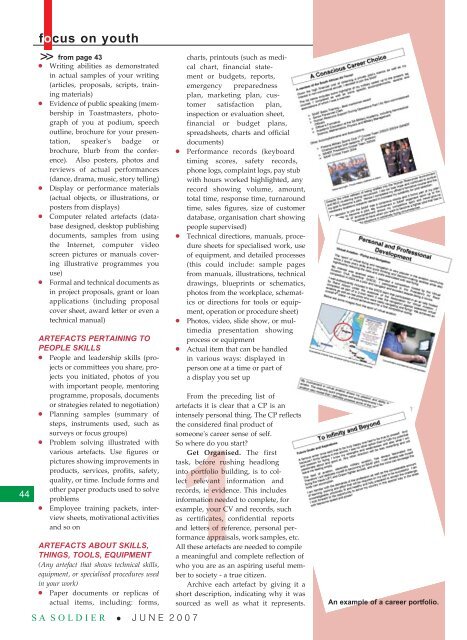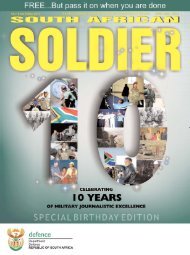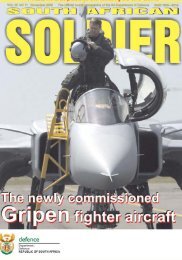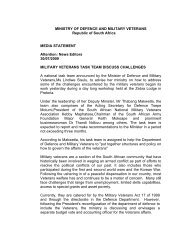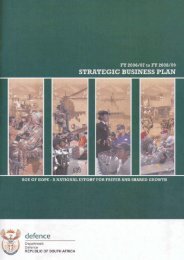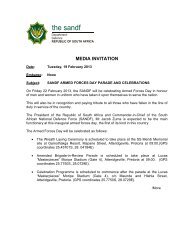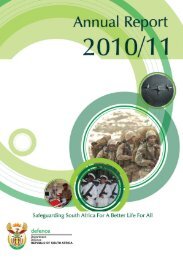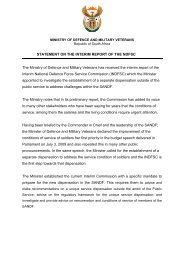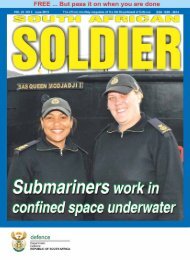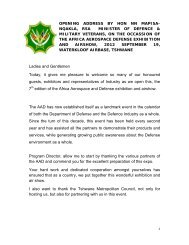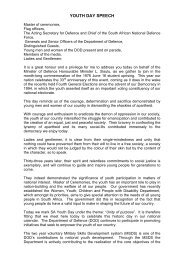JUNE - Department of Defence
JUNE - Department of Defence
JUNE - Department of Defence
Create successful ePaper yourself
Turn your PDF publications into a flip-book with our unique Google optimized e-Paper software.
44<br />
focus on youth<br />
>> from page 43<br />
<br />
<br />
<br />
<br />
<br />
Writing abilities as demonstrated<br />
in actual samples <strong>of</strong> your writing<br />
(articles, proposals, scripts, training<br />
materials)<br />
Evidence <strong>of</strong> public speaking (membership<br />
in Toastmasters, photograph<br />
<strong>of</strong> you at podium, speech<br />
outline, brochure for your presentation,<br />
speaker's badge or<br />
brochure, blurb from the conference).<br />
Also posters, photos and<br />
reviews <strong>of</strong> actual performances<br />
(dance, drama, music, story telling)<br />
Display or performance materials<br />
(actual objects, or illustrations, or<br />
posters from displays)<br />
Computer related artefacts (database<br />
designed, desktop publishing<br />
documents, samples from using<br />
the Internet, computer video<br />
screen pictures or manuals covering<br />
illustrative programmes you<br />
use)<br />
Formal and technical documents as<br />
in project proposals, grant or loan<br />
applications (including proposal<br />
cover sheet, award letter or even a<br />
technical manual)<br />
ARTEFACTS PERTAINING TO<br />
PEOPLE SKILLS<br />
People and leadership skills (projects<br />
or committees you share, projects<br />
you initiated, photos <strong>of</strong> you<br />
with important people, mentoring<br />
programme, proposals, documents<br />
or strategies related to negotiation)<br />
Planning samples (summary <strong>of</strong><br />
steps, instruments used, such as<br />
surveys or focus groups)<br />
Problem solving illustrated with<br />
various artefacts. Use figures or<br />
pictures showing improvements in<br />
products, services, pr<strong>of</strong>its, safety,<br />
quality, or time. Include forms and<br />
other paper products used to solve<br />
problems<br />
Employee training packets, interview<br />
sheets, motivational activities<br />
and so on<br />
ARTEFACTS ABOUT SKILLS,<br />
THINGS, TOOLS, EQUIPMENT<br />
(Any artefact that shows technical skills,<br />
equipment, or specialised procedures used<br />
in your work)<br />
Paper documents or replicas <strong>of</strong><br />
actual items, including: forms,<br />
S A S O L D I E R J U N E 2 0 0 7<br />
<br />
<br />
<br />
<br />
charts, printouts (such as medical<br />
chart, financial statement<br />
or budgets, reports,<br />
emergency preparedness<br />
plan, marketing plan, customer<br />
satisfaction plan,<br />
inspection or evaluation sheet,<br />
financial or budget plans,<br />
spreadsheets, charts and <strong>of</strong>ficial<br />
documents)<br />
Performance records (keyboard<br />
timing scores, safety records,<br />
phone logs, complaint logs, pay stub<br />
with hours worked highlighted, any<br />
record showing volume, amount,<br />
total time, response time, turnaround<br />
time, sales figures, size <strong>of</strong> customer<br />
database, organisation chart showing<br />
people supervised)<br />
Technical directions, manuals, procedure<br />
sheets for specialised work, use<br />
<strong>of</strong> equipment, and detailed processes<br />
(this could include: sample pages<br />
from manuals, illustrations, technical<br />
drawings, blueprints or schematics,<br />
photos from the workplace, schematics<br />
or directions for tools or equipment,<br />
operation or procedure sheet)<br />
Photos, video, slide show, or multimedia<br />
presentation showing<br />
process or equipment<br />
Actual item that can be handled<br />
in various ways: displayed in<br />
person one at a time or part <strong>of</strong><br />
a display you set up<br />
From the preceding list <strong>of</strong><br />
artefacts it is clear that a CP is an<br />
intensely personal thing. The CP reflects<br />
the considered final product <strong>of</strong><br />
someone's career sense <strong>of</strong> self.<br />
So 1where do you start?<br />
Get Organised. The first<br />
task, before rushing headlong<br />
into portfolio building, is to collect<br />
relevant information and<br />
records, ie evidence. This includes<br />
information needed to complete, for<br />
example, your CV and records, such<br />
as certificates, confidential reports<br />
and letters <strong>of</strong> reference, personal performance<br />
appraisals, work samples, etc.<br />
All these artefacts are needed to compile<br />
a meaningful and complete reflection <strong>of</strong><br />
who you are as an aspiring useful member<br />
to society - a true citizen.<br />
Archive each artefact by giving it a<br />
short description, indicating why it was<br />
sourced as well as what it represents.<br />
An example <strong>of</strong> a career portfolio.


